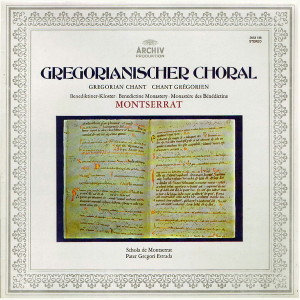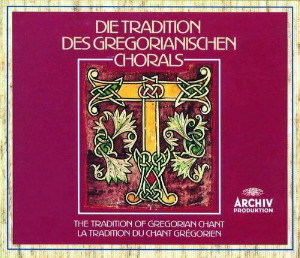 |
|
1 LP -
2533 158 - (p) 1974
|
 |
| 4 CD's -
435 032-2 - (c) 1993 |
|
| THE TRADITION OF
THE GREGORIAN CHANT - (II) |
|
|
|
|
|
|
|
|
MONTSERRAT
- Benedictine Monastery
|
|
|
|
|
|
|
|
|
|
| RESPONSORIA
AD MATUTINUM IN NATIVITATE DOMINI
IUXTA RITUM MONASTICUM |
|
|
44' 00" |
|
| -
Responsorium I - Hodie nobis
caelorum rex |
Tonus
V |
6' 29" |
|
A1 |
| -
Responsorium II - Hodie nobis de
caelo pax |
Tonus
VIII |
2' 31" |
|
A2 |
| -
Responsorium III - Quem vidistis
pastores |
Tonus
IV |
2' 42" |
|
A3 |
| -
Responsorium IV - Descendit de
caelis |
Tonus
I |
4' 11" |
|
A4 |
| -
Responsorium V - O magnum mysterium |
Tonus
III |
3' 29" |
|
A5 |
| -
Responsorium VI - Beata dei genitrix |
Tonus
VII |
2' 20" |
|
A6 |
| -
Responsorium VII - Sancta et
immaculata virginitas |
Tonus
II |
2' 29" |
|
B1 |
| -
Responsorium VIII - Angelus ad
pastores ait |
Tonus
VII |
3' 29" |
|
B2 |
| -
Responsorium IX - Ecce agnus dei |
Tonus
VII |
3' 57" |
|
B3 |
| -
Responsorium X - Beata viscera |
Tonus
VII |
3' 50" |
|
B4 |
| -
Responsorium XI - In principio erat
verbum |
Tonus
VII |
3' 00" |
|
B5 |
| -
Responsorium XII - Verbum caro
factum est |
Tonus
VIII |
5' 01" |
|
B6 |
|
|
|
|
|
| Source:
Liber Responsorialis, Tournai
(Desclée) |
|
|
|
|
| SCHOLA DES
KLOSTERS MONTSERRAT |
| Pater Gregori
Estrada, Leitung |
|
|
|
|
Luogo
e data di registrazione |
|
Klosterkirche
Montserrat (Spagna) - 14/17 marzo
1973 |
|
|
Registrazione:
live / studio |
|
studio |
|
|
Production |
|
Dr.
Andreas Holschneider |
|
|
Recording
supervision |
|
Heinz
Wildhagen |
|
|
Recording Engineer |
|
Heinz
Wildhagen |
|
|
Prima Edizione LP |
|
ARCHIV
- 2533 158 - (1 LP - durata 44'
00") - (p) 1974 - Analogico |
|
|
Prima Edizione CD |
|
ARCHIV
- 435 032-2 - (4 CD's - durata 78'
14"; 73' 13"; 71' 18" & 73'
54" - [CD1 1-12]) - (c) 1993 - ADD
|
|
|
Cover |
|
MS 72
Bibliothek Montserrat, 12. Jh.,
pag. 26/27; 24,2 cm x 14,7 cm. R.
O magnum misterium etc.
(Aquitanisch-katalanische
Notation)
|
|
|
Note |
|
-
|
|
|
|
|
The Tradition of
the Gregorian Chant (II)
Montserrat -
The Responsoria of Matins at
Christmas
The offices of the canonical
hours, sung at appointed times
throughout the day and night in
Benedictine communities, begin
at midnight with matins, at once
a highpoint of the entire cycle.
It is so not only on account of
the admirable construction of
this office and its - by
comparison with the Mass -
greater textual variety, but
also by virtue of its music; its
principal chants, the twelve
responsoria, form a particularly
impressive group within the
immense corpus of several
thousand plainsong melodies. If
these chants are to be fully
appreciated two points should be
borne in mind. Firstly, as in
the Mass the responsorial chants
regularly follow a lesson - they
are “concert pieces”, during
which the liturgical action
ceases and all present,
including the celebrant, listen
to the singing. Secondly, as its
name suggests, the responsorium
is an “answering” song. It is
centred upon the presentation of
a psalm or, as here, a freely
written text, its verses being
sung by one or more soloists to
one of the eight modal melodies
known as psalm tones, while the
choir reply with a longer
response in the nature of a
refrain. Every listener will at
once appreciate the fine effect
of the sequence, which is
clearly evident in the shaping
of its melodies: choral
responsorium - solo verse -
repetition of the choral
responsorium (although since the
beginning of written records in
the 9th century only its second
half has been repeated). There
is a third factor to be
considered: those present at
matins are aware of all the
responsoria of a festival as
parts of a larger organism,
whose structure is destroyed if
one or more sections are sung in
isolation. It is more in keeping
with the intended effect to
present in their entirety the
twelve responsorial chants for a
single festival, in this case
Christmas. (The absence of the
lesson which precedes each piece
in the liturgical context is
less important.) The texts of
the responsoria, most of which
are free prose passages of great
lyrical beauty and profundity of
ideas, throw light on the
mystery of Christmas from ever
new aspects: redemption through
the Incarnation, the shepherds,
even the ox and ass (animalia)
at the crib, the angels, the
Virgin Mother Mary, John the
Baptist who foretells the coming
of the Lamb of God, and finally
the beginning of St. John’s
Gospel telling of the Logos, the
Word become flesh - every
possible element of the story is
drawn upon so that the joy of
the festival can be savoured in
every way.
Fundamental to an understanding
of the plainsong melodies, which
are some thirteen centuries old
- recent research dates them
during the second half of the
7th century - is an appreciation
of their intimate connection
with the words. The Roman
melodies are not intended to
impart feelings so much as to
bring out the meaning of the
words, so that they will be as
understandable as possible to
the listeners. Anyone who
follows the words printed here
will be able to hear how Roman
musicians made the form of the
text both visible and audible,
because at a single vertical
stroke the rest in the melody is
shorter than at the double
stroke which occurs when the
conclusion of a particular idea
marks the end of a passage. The
function of final phrases is
emphasized by melismata, the
increased musical elaboration of
particular syllables,
represented here by slanting
print. Psalmody, i. e. the verse
melody sung by the soloist, is
always in two sections, simpler
at its centre and more richly
ornamented towards its close.
This definition of plainsong as
a means of achieving “heightened
declamation of the words” only
appears to limit its scope. It
is in fact a thing of musical
beauty such as can scarcely be
described in words. The fact
that plainsong combines these
two characteristics, faithful
service to the words and the
apparently unhindered unfolding
of beautiful melody in a manner
which may truly be described as
classical, makes it one of the
really great musical phenomena
of all times.
A few indications may make it
easier to appreciate some of the
telling effects contained in the
music. It will be noticed that
in the 1st responsorium the
first and last passages (at
“dignatus est” and to an even
greater extent at “apparuit”)
sink gracefully down from a high
level to the fundamental note.
The same striking effect occurs
in the 2nd responsorium at
“descendit” and “sunt caeli”. In
contrast to the animated melodic
line of these first two pieces,
the third, a dialogue with the
shepherds, is more tranquil.
“Descendit de caelis”, the 4th
responsorium, which follows,
concludes the first group of
four chants, the first of the
three nocturns - the principal
sections of matins. This is also
the reason why the last
responsorium of each nocturn has
a second verse, namely the
doxology “Gloria patri...”, a
last reminder of its early
version with several verses,
which has not come down to us. A
strongly expressive “O!” begins
the 5th responsorium, whose
melody is embellished with
numerous melismata emphasizing
its crucial words. In No. 6,
“Beata dei genitrix”, we again
admire the peaceful conclusion
of the two main sections. The
shorter text of No. 7, “Sancta
et immaculata”, is matched by a
less expansive and less
ornamented melody. By contrast
No. 8, “Angelus ad pastores”,
which follows, is again richer
in its musical setting; after
its rapid opening phrase the
ange1’s discourse reaches its
climax at “annuntio vobis”, then
again becoming more placid (as
in so many other instances) at
“gaudium magnum” which follows.
(The same effect occurs at “omni
populo”, “dominus” and “civitate
David”.) The first responsorium
of the third nocturn, No. 9,
“Ecce agnus dei”, a very
extensive piece, includes three
exclamations of “Ecce!” (a word
translated as “behold!”, but
this lacks the depth of meaning
of the Latin expression). The
third “Ecce!”, set to almost
thirty notes, rises to a very
high pitch, and with the “de quo
dicebam vobis” forms the climax
of the impressive, impassioned
declaration of John the Baptist.
In responsorium No. 10, “Beata
viscera”, the crucial words “Qui
hodie pro salute mundi de
virgine nasci dignatus est”, the
idea at the very heart of the
festival of Christmas, are
presented most vividly to the
listener by means of the
high-lying and richly
embellished melody. The opening
words of St. John’s Gospel are
divided between the last two
responsoria: the animated “In
principio” and the rather more
tranquil “Verbum caro”, in which
we encounter on three occasions
the already familiar and
beautiful effect of the melody
seeming to sway down to the
fundamental note (“in nobis”,
“eius” and “veritatis”); this
last responsorium is unusual in
that its versicle does not
adhere to the traditional
pattern, here of the 8th psalm
tone as used for the 2nd
responsorium; the fact that it
is, unusually, in three
sections, and its jagged,
restless line, show this new
piece of psalmody to be a later
composition.
The Benedictine monastery of
Montserrat, founded soon after
1000 A. D., which lies high in
the mountains to the west of
Barcelona, can look back on a
long and glorious musical
heritage, unequalled anywhere
else in Spain. The singing of
the present-day Escolanía
(Schola) is distinguished by its
refreshingly lively manner of
presentation, with great
rhythmical elasticity and
freedom. One can imagine that
the melodies were sung in this
manner, or something like it, in
Mediterranean countries at the
time of their composition.
The twelve responsoria are
included in the Liber
Responsorialis published by the
Benedictines of Solesmes, 1st
edition, page 56 et seq. In some
cases the monks of Montserrat
sing from better manuscript
versions, which were unknown or
had not yet found favour at
Solesmes nearly eighty years ago.
Bruno
Stäblein
|
|
|

